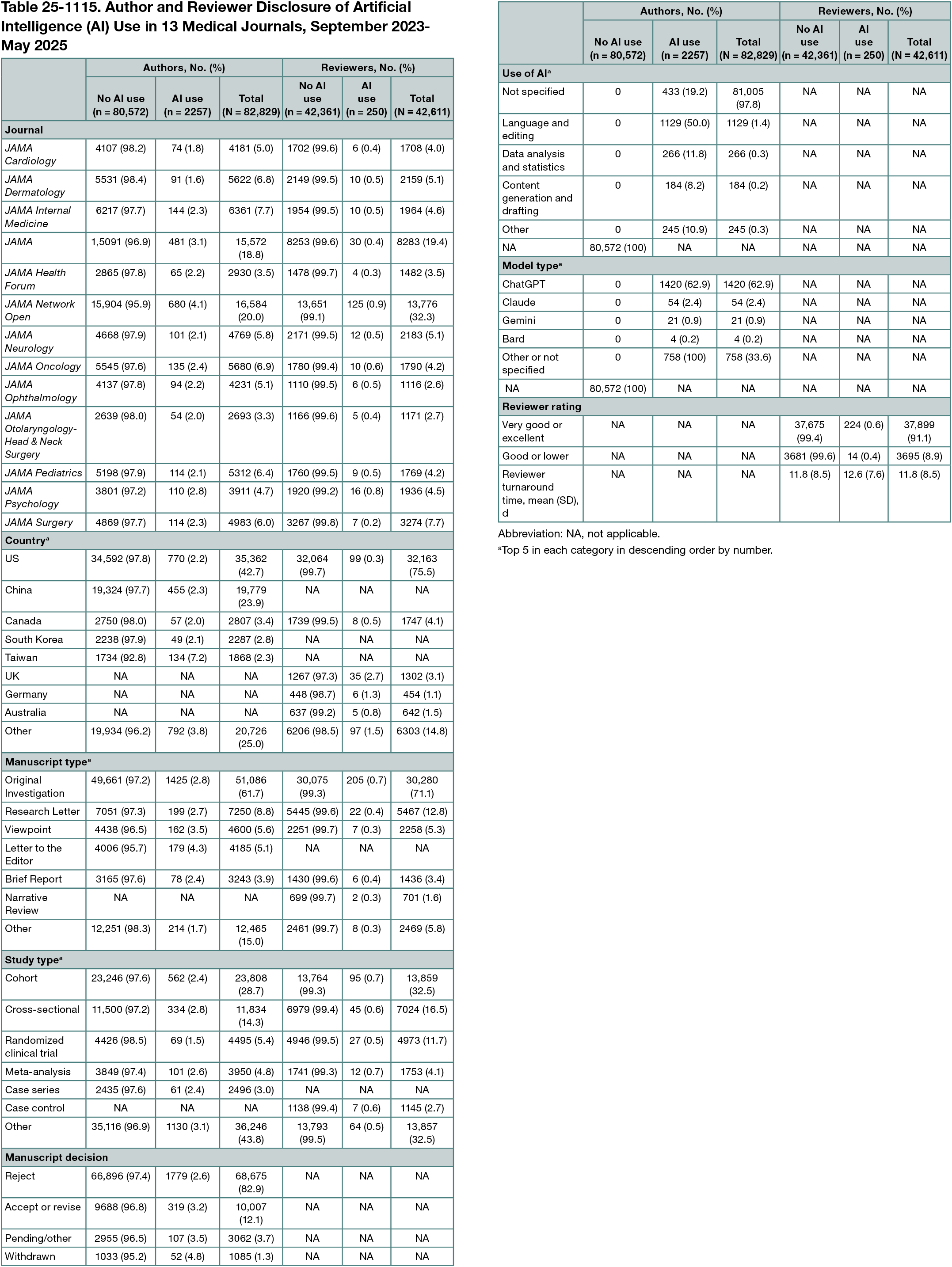Abstract
Factors Associated With Author and Reviewer Declared Use of AI in Medical Journals
Roy H. Perlis,1,2 Annette Flanagin,3 Jacob Kendall-Taylor,3 Michael Berkwits,4 Kirsten Bibbins-Domingo3
Objective
The scientific community is divided about the appropriate role of artificial intelligence (AI) in manuscript preparation.1 In 2023, JAMA Network journals began requiring authors and reviewers to answer questions about use of AI to create or assist in the creation or editing of submitted manuscripts or with preparation of reviews.2 This study was conducted to assess author and reviewer declarations of such use.
Design
Study of manuscripts and peer reviews submitted to 13 JAMA Network journals from September 2023 to May 2025. Numbers and proportions of manuscripts with corresponding authors and peer reviewers declaring use of AI were examined, along with factors associated with use (eg, journal, country, article type). For authors’ use, reasons, type of AI, and editorial decisions were also assessed; for reviewers’ use, turnaround time and ratings of reviews were assessed. Where sample sizes were sufficient, logistic regression models were run, with use of AI as the dependent variable and article type, journal, and review outcome as independent variables. A 2-sided uncorrected P value of <.05 was considered the threshold for statistical significance. This study was deemed exempt from ethical approval by the Mass General Brigham Institutional Review Board.
Results
Of 82,829 manuscripts submitted during the study period, 2257 (2.7%) declared AI use. Authors’ use of AI increased from 1.6% in September 2023 to 4.2% in May 2025 (r2 = .34; P < .01). Table 25-1115 contrasts manuscripts with or without disclosed AI use by author country, journal, manuscript type, study type, editorial decision, AI use categories, and common AI models used. Author AI use was highest in JAMA Network Open (4.1%) and JAMA (3.1%) and lowest in JAMA Dermatology (1.6%) and was highest among authors from Taiwan (7.2%). Letters to the Editor (odds ratio [OR] 1.63, 95% CI 1.37-1.94) and Viewpoints (OR 1.44, 95% CI 1.21-1.72) were more likely to involve AI use than Original Investigations. The most common reported reasons for AI use by authors were for language and editing (50.0%), data analysis and statistics (11.8%), and content generation and drafting (8.2%). ChatGPT was the most common AI model used by authors (62.9%). Mean (SD) reviewer turnaround times were 11.8 (8.5) days for those who did not disclose AI use and 12.6 (7.6) days for reviewers who disclosed AI use. Reviewer use of AI was highest for JAMA Network Open (0.9%) and JAMA Psychiatry (0.8%) and among reviewers from the UK (2.7%).
Conclusions
Among manuscripts submitted to 13 major medical journals, author declaration of AI use to create or edit content was low but more than doubled during the study period and varied by journal and article type. Very few reviewers disclosed use of AI, possibly because of guidance forbidding such use.3 Limitations include small numbers of reported AI use, which limited comparisons for some factors, and the likelihood of underreporting of AI use.
References
1. Kwon D. Is it OK for AI to write science papers? Nature survey shows researchers are split. Nature. 2025;641:574-578. doi:10.1038/d41586-025-01463-8
2. Flanagin A, Pirracchio R, Khera R, Berkwits M, Hswen Y, Bibbins-Domingo K. Reporting use of AI in research and scholarly publication—JAMA Network guidance. JAMA. 2024;331(13):1096-1098. doi:10.1001/jama.2024.3471
3. Flanagin A, Kendall-Taylor J, Bibbins-Domingo K. Guidance for authors, peer reviewers, and editors on use of AI, language models, and chatbots. JAMA. 2023;330(8):702-703. doi:10.1001/jama.2023.12500
1JAMA+ AI and JAMA Network Open, Chicago, IL, rperlis@mgh. harvard.edu; 2Department of Psychiatry, Mass General Brigham, Boston, MA, US; 3JAMA and the JAMA Network, Chicago, IL, US; 4Centers for Disease Control and Prevention, Atlanta, GA, US.
Conflict of Interest Disclosures
Roy H. Perlis receives payment for service as a scientific advisor to Circular Genomics, Genomind,and Alkermes. Annette Flanagin, Michael Berkwits, and Kirsten Bibbins-Domingo are members of the Peer Review Congress Advisory Board but were not involved in the review or decision for this abstract.
Additional Information
Llama 3.3 (Ollama) was used on June 13, 2025, to identify categories of author-declared use of artificial intelligence. Roy H. Perlis takes responsibility for the integrity of the content generated.

